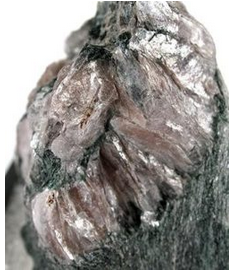6.4.5: Micas
- Page ID
- 18918
| Micas (K,Na,Ca)(Al,Mg,Fe)2-3(Si,Al)4O10(OH)2 general formula: X Y2-3Z4O10(OH)2 |
|
| Most important end members | |
| muscovite annite phlogopite |
KAl2(AlSi3O10)(OH)2 KFe3(AlSi3O10)(OH)2 KMg3(AlSi3O10)(OH)2 |
| Others | |
| margarite paragonite lepidolite |
CaAl2(Al2Si2O10)(OH)2 NaAl2(AlSi3O10)(OH)2 K(Li,Al)2(AlSi3O10)(OH)2 |
We just looked at framework silicates. In those minerals, all four oxygen in SiO4 and AlO4 tetrahedra are shared with another tetrahedron. This is what creates the 3-dimensional framework. In sheet silicates, tetrahedra only share three out of four of their oxygen with adjacent tetrahedra. The most important groups of minerals within the sheet silicate subclass are micas, chlorites, and clays. We will consider only the micas and, to a lesser extent, chlorites, in this chapter and defer discussion of clay minerals to the chapter on sedimentary rocks and minerals.
Micas have the general formula XY2-3Z4O10(OH)2. Some specific formulas are given in the blue box above. The X atoms are most often K and, less commonly Na or Ca, or rarer elements. If the X atom is K or Na, we call the mica a common mica, if it is Ca (e.g., in margarite), we call the mica a brittle mica. Y atoms are generally Al, Mg, or Fe, and less often Mn, Cr, Ti, or Li. Z atoms are mostly Si, with lesser amounts of Al, and even lesser amounts of Fe or Ti. Additionally, some Cl or F may substitute for (OH). So, micas have highly variable chemistry. Structurally, micas are classified as dioctahedral if the number of Y atoms is 2, and trioctahedral if the number of Y atoms is 3. Intermediate micas, part way between dioctahedral and trioctahedral, do not exist. Of the micas listed in the box, muscovite, margarite, paragonite, and lepidolite are all dioctahedral; annite and phlogopite are trioctahedral. The photos below show examples common micas.






By far, the most abundant micas are muscovite and biotite. Biotite is the name we use for micas that are mosty solid solutions of phlogopite and annite. Muscovite is more common than biotite, but both occur in a wide variety of igneous and metamorphic rocks. Muscovite (Figure 6.62, above) is dioctahedral and is usually close to the end-member composition KAl2(AlSi3)O10(OH)2. Without chemical analysis, it is sometimes hard to distinguish it from other silvery dioctahedral micas such as margarite (Figure 6.65), paragonite (Figure 6.66), and lepidolite (Figure 6.67). Biotite (Figure 6.63), K(Fe,Mg)3(AlSi3)O10(OH)2, is trioctahedral and may have any composition between the two end members annite and phlogopite (see formulas in the blue box above). Biotite sometimes incorporates a very small amount of muscovite as well.
Micas react to form clays and other minerals when exposed to prolonged weathering, and are therefore absent from most sedimentary rocks. Biotite, and especially muscovite, are relatively Al- and Si-rich compared with many other igneous minerals. Muscovite, therefore, is found in silicic igneous rocks such as granite, but rarely in rocks of intermediate or mafic composition. Biotite is found in rocks ranging from granitic to mafic composition. Phlogopite is occasionally found in ultramafic rocks.
The name annite refers only to the ideal iron-rich mica end member, but the name phlogopite is often used in a more general sense to describe any magnesium-rich biotite. Phlogopite is often brown, compared to the more common black color of biotite, so many geologists use the names muscovite, phlogopite, and biotite in a generic sense to refer to silvery, brownish, and black micas, respectively.
Besides Al-Fe-Mg substitutions, other substitutions, such as F– substituting for OH–, occur in micas, but they are generally minor. Lepidolite, an especially lithium-rich mica similar to muscovite, is an exception. It is a common large and euhedral mineral in pegmatites, and is often associated with the lithium-aluminum pyroxene, spodumene. The photo of lepidolite in Figure 6.67 has the typical lilac color of this mineral, but lepidolite may be yellow or other colors as well.

The drawing in Figure 6.68 shows the atomic arrangement in muscovite. The arrangement is just about the same in all micas, and other sheet silicates have atomic structures that are closely related to muscovite’s. Micas contain sheets (layers) of (Si,Al)O4 tetrahedra with alkalis and other metals between. Most micas, like muscovite, contain K+ as an interlayer cation between the tetrahedral layers. Depending on the mica species, Fe2+ , Mg2+ , and Al3+ occupy positions between the apices of the tetrahedra. Within the tetrahedra themselves, Al3+ substitutes for some Si4+.
Bonding within a sheet (O2- bonded to Si4+ and Al3+ in muscovite) is much stronger than bonding between sheets (K+ bonded to O2- in muscovite). Consequently, well-developed basal cleavage (planar and sheet-like) characterizes mica and most other sheet silicates. See the photos above in Figures 6.62 to 6.67 and also the biotite in Figure 3.59 (Chapter 3)

The name chlorite is often used in a general way to refer to any greenish mica. But, strictly speaking, chlorite is a group of minerals consisting of a number of different species that are difficult to distinguish from each other. Chlorite compositions can be described by the simplified formula (Mg,Fe)3(Si,Al)4O10(OH)2∙n(Mg,Fe)3(OH)6. The photo in Figure 6.69 shows a rare bluish example of chlorite.
Chlorite’s atomic arrangement is similar to the arrangement in micas but the interlayer site contains (Mg,Fe)(OH)6 instead of K. Clinochlore – (Mg5Al)(AlSi)3O10(OH)8 – is perhaps the most important chlorite end member. Chlorite group minerals are stable over a wide range of conditions, generally occurring in low to medium-grade metamorphic rocks. They are also common as alteration products in igneous rocks, where they form from biotite, pyroxene, amphibole, and other mafic minerals.


